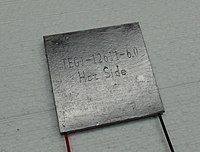
Photo from wikipedia
Two-dimensional inorganic–organic hybrids are important due to tunable physical properties and their suitability in the data storage, memory devices, low-temperature magnetic refrigeration technology, energy storage, and other applications. The significance… Click to show full abstract
Two-dimensional inorganic–organic hybrids are important due to tunable physical properties and their suitability in the data storage, memory devices, low-temperature magnetic refrigeration technology, energy storage, and other applications. The significance of such lead-free layered hybrids is in the ease of synthesis and material stability against heat, humidity, temperature, and other environmental conditions. Here, we report the magnetic properties of (C12H25NH3)2Cu(Br1 – xClx)4 and (C6H9C2H4NH3)2Cu(Br1 – xClx)4 systems that are self-assembled layered structures formed by solution processing. The systems exhibit paramagnetic to ferromagnetic transition with the Curie temperature and amount of magnetization both controllable by halogen content in the stoichiometric composition. Magnetocaloric properties have been investigated to find out the suitability of highly stable (C12H25NH3)2CuCl4 in environment friendly low-temperature magnetic refrigeration technology. A large magnetic entropy change varying from ∼0.6 J kg−1 K−1 to larger than 2.0 J kg−1 K−1 is measured from isothermal magnetization data around the Curie temperature at field variations 0–10 kOe and 0–60 kOe, respectively. Characteristic critical exponents from the field-dependent magnetic entropy changes have been determined, which show excellent agreement with the three-dimensional Heisenberg model.Two-dimensional inorganic–organic hybrids are important due to tunable physical properties and their suitability in the data storage, memory devices, low-temperature magnetic refrigeration technology, energy storage, and other applications. The significance of such lead-free layered hybrids is in the ease of synthesis and material stability against heat, humidity, temperature, and other environmental conditions. Here, we report the magnetic properties of (C12H25NH3)2Cu(Br1 – xClx)4 and (C6H9C2H4NH3)2Cu(Br1 – xClx)4 systems that are self-assembled layered structures formed by solution processing. The systems exhibit paramagnetic to ferromagnetic transition with the Curie temperature and amount of magnetization both controllable by halogen content in the stoichiometric composition. Magnetocaloric properties have been investigated to find out the suitability of highly stable (C12H25NH3)2CuCl4 in environment friendly low-temperature magnetic refrigeration technology. A large magnetic entropy change varying fr...
Journal Title: Journal of Applied Physics
Year Published: 2020
Link to full text (if available)
Share on Social Media: Sign Up to like & get
recommendations!